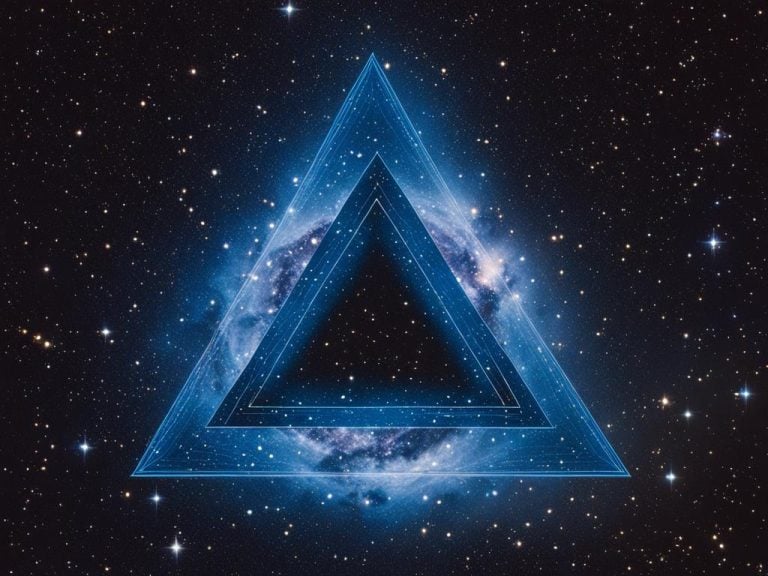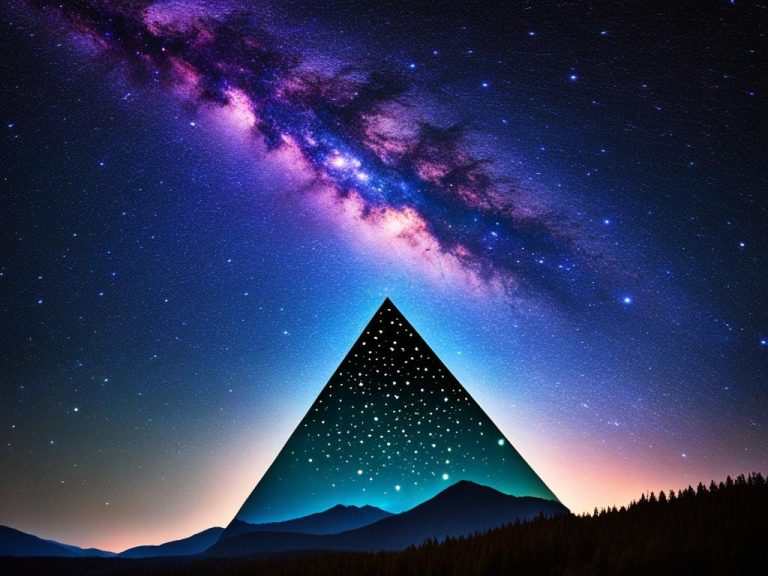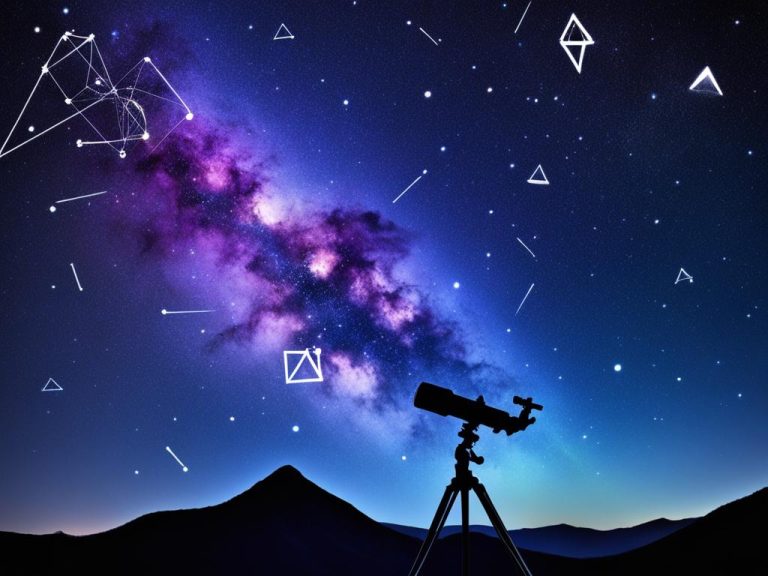Exploring the Mysteries of the Triangulum Constellation
Did you know that the Triangulum constellation is small but very important? It is a big deal in many cultures. This group of stars has amazed people for a long time.
In Greek tales, Triangulum is part of Perseus‘ story. He was a great hero who defeated the Gorgon Medusa. Three stars in the constellation make a delta shape. This shape stands for Perseus’ tool, Medusa’s head.
In Chinese stories, Triangulum is the White Tiger of the West. It’s one of the Four Symbols that show different directions. The White Tiger is thought to watch over the sky. It also brings good luck.
Triangulum has been a big help to sailors and travelers over time. Its shape made it a useful map in the sky. It guided people over the sea when the path was unknown.
Have you ever gazed at the stars and wanted to know their stories? Triangulum is a great place to start. Its stories are interesting and will make you want to learn more.

Key Takeaways
- The Triangulum constellation holds rich cultural significance across various civilizations.
- Triangulum is associated with the heroic tale of Perseus in Greek mythology.
- In Chinese astronomy, Triangulum is linked with the White Tiger of the West, symbolizing luck and protection.
- Triangulum has served as a navigational aid for sailors and travelers throughout history.
- Exploring the Triangulum constellation opens a gateway to the wonders of the night sky.
History and Mythology of the Triangulum constellation
The constellation Triangulum has a rich history and mythology. It spans across cultures and civilizations. We’ll dive into the ancient stories and beliefs about this constellation.
In Greek mythology, Triangulum is linked to Perseus and Medusa. Perseus, a hero, killed Medusa and saved Andromeda. This action created a triangular shape in the night sky.
Chinese astronomy sees Triangulum as the White Tiger of the West. This symbolizes strength and protection. It shows the constellation’s special role in their beliefs.
Over history, Triangulum guided sailors and travelers. Its shape helped in finding direction while sailing. This way, seafarers could explore new places.
To explore more about Triangulum’s mythology and history, visit these resources:
- Constellation Guide gives a complete view of Triangulum, including stars and history.
- Sea and Sky a great site for detailed info on Triangulum, its mythology, and location in the night sky.
- Wikipedia offers extensive details about Triangulum’s mythology, history, and science.
Exploring Triangulum’s history and myths helps us value its cultural significance. These celestial wonders have fascinated people for centuries.
Naming a Star in Triangulum
Imagine a star with your name in the sky. International Star Registry can make it real in Triangulum. It’s a special way to mark life’s special moments or show love.
Visit StarRegistry.com to pick a star in Triangulum. You can name one for any special time or just because. This star gift comes with a name certificate and its exact location in the sky.
Naming a star in Triangulum links you to the vast and captivating universe. Plus, it’s your chance to create a legacy for your family.
Don’t wait any longer. Visit StarRegistry.com and start your journey to name a star after someone in Triangulum today.

References:
Significance of Naming a Star
Naming a star is more special than you may think. It’s a chance to save special times and honor our loved ones. It works for any unique gift or for big moments in life. Buying a star in the Triangulum constellation makes this experience truly unforgettable.
When you buy a star for someone in Triangulum with International Star Registry, you do more than just point out a star. You create a memory that lasts forever. Just think about looking at the stars and knowing one of them has your chosen name.
International Star Registry has been naming stars for over 45 years. They are experts at making sure your star is always visible. Each star you name goes into the star catalog “Your Place in the Cosmos.” This lets you find your star whenever you look.
For birthdays, anniversaries, or any special day, naming a star in Triangulum is perfect. It shows the beauty and mystery of the universe. It’s a different but heartwarming way to say you care, honor a memory, or show someone’s importance.
Experience the happiness of naming a star in Triangulum. Give a star gift that will be valued forever. Visit www.starregistry.com to learn more and start your cosmic journey.
Introduction to Triangulum
Triangulum means “triangle” in Latin. It’s a small constellation found in the northern part of the sky. It looks like a triangle. Even though it covers just 131 square degrees, it’s very important in culture and history.

People have told stories and myths about Triangulum for a long time. The ancient used its triangle shape to create tales. Both scientists and people who love looking at the stars find it interesting.
Today, we value Triangulum for its beauty and what it teaches us. Scientists look at its stars to learn more about our universe. This constellation helps us understand outer space and our role in it.
Stars of Triangulum
The Triangulum constellation is full of vibrant and captivating stars in the night sky. This includes the three brightest stars: Beta Trianguli, Alpha Trianguli, and Gamma Trianguli.
Beta Trianguli is the Brightest Star of the constellation, known for its mesmerizing binary system. Science calls such systems binary because they consist of two stars dancing around a center. This dance creates a beautiful cosmic show.
Alpha Trianguli, or “Mothallah,” is a subgiant in its late life stage. Even though it’s old, it shines very brightly. Its shine highlights the constellation’s beauty and importance.
Gamma Trianguli, the third brightest in Triangulum, is a young star still in the first stage of its life. It’s busy turning hydrogen into helium, shining brightly. Its young light brings life and energy to Triangulum.
The bright stars Beta Trianguli, Alpha Trianguli, and Gamma Trianguli give Triangulum its unique look. Their special features make Triangulum a stunning sight for anyone who likes stars.
Go on and learn why Triangulum is so important. Find out the best ways to see this incredible constellation for yourself.
Historical Significance of Triangulum
Triangulum, a group of stars, is very important to people who love looking at the sky. It has amazed people for a long time. From old stories to new facts, Triangulum is always interesting.
A long time ago, the people of Babylon saw Triangulum as a plough for farming in the sky. The Greeks thought the stars looked like a delta, a big triangle. In the Middle Ages, it was called “The Mitre,” like a hat a bishop wears. These names show how different cultures have seen Triangulum over time.
Now, Triangulum is still special among the stars we see. It is the 78th biggest today. You can find it next to the Andromeda and Aries constellations. It’s easy to see in the night sky.
One cool thing you can see there is the Triangulum Galaxy, or M33. It’s the third largest in our local group of galaxies. You can see its pretty shape with just binoculars or a small telescope. It looks bright and beautiful with a rating of +5.7.
If you want to learn more about Triangulum’s stories and science, click these links:
– theplanets.org
– skyatnightmagazine.com
Triangulum Ancient Interpretations
More than 2,000 years ago, the Greek Ptolemy put Triangulum on the map. Its stories and connections to myths make it stand out. It’s part of the story of Perseus and other constellations like Andromeda.
There are 322 stars in Triangulum. The brightest one, Beta Trianguli, is not super bright at 3.00. But, every star here adds to its beauty in the night sky.
Next time you see Triangulum, think about its past. Consider the myths and history that make it what it is today.
Locating and Observing Triangulum
When we explore the night sky, Triangulum is a must-see. It lies between Andromeda and Aries in the Northern Hemisphere. This makes finding it quite simple.
To locate Triangulum, find the Great Square of Pegasus first. Then, head east to Andromeda and south to Triangulum. Its shape is like a clear triangle among the stars.
Observing Triangulum is easy with just your eyes. But using binoculars or a small telescope makes it even better. You can see more clearly, like the stars forming its shape.
The Triangulum Galaxy, or M33, is a key part of this constellation. It is a spiral galaxy about 3 million light-years from Earth. This makes it one of the farther things we can see without help.
If you enjoy looking at the stars, finding Triangulum is fulfilling. Its unique form and a galaxy far away have much to show us. Triangulum reflects the vast and stunning universe we live in.
Conclusion
The Triangulum constellation has amazed people for many years. It has a long history and stories from various cultures. You can name a special star here with International Star Registry.
Naming a star after someone in Triangulum is a very special thing. It lets you feel close to the stars and universe. It’s a great gift that lasts forever, perfect for special moments or as a gift to a loved one.
Visit StarRegistry.com to see the stars in Triangulum. There, you can find the perfect star gift.
FAQ
Can I name a star in the Triangulum constellation?
Yes, you can name a star in the Triangulum constellation. Just visit StarRegistry.com.
What do I get when I name a star in Triangulum?
Once you name a star, you get a certificate with its name and location. This includes the star’s exact astronomical coordinates.
Why should I name a star in Triangulum?
Naming a star celebrates special moments. It’s a unique gift for loved ones. It leaves a legacy across space and time.
How do I locate the Triangulum constellation?
Look between Andromeda and Aries to find Triangulum. Start by finding the Great Square of Pegasus. Move east to Andromeda and then south to Triangulum.
How can I purchase a star in Triangulum as a gift?
To buy a star in Triangulum, go to StarRegistry.com. Follow the steps to uniquely name a star after someone. You can customize the certificate and choose a special name.
